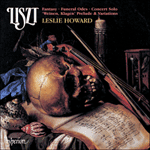
Welcome to Hyperion Records, an independent British classical label devoted to presenting high-quality recordings of music of all styles and from all periods from the twelfth century to the twenty-first.
Hyperion offers both CDs, and downloads in a number of formats. The site is also available in several languages.
Please use the dropdown buttons to set your preferred options, or use the checkbox to accept the defaults.

| Leslie Howard (piano)» More |
from notes by Leslie Howard © 1989
 Liszt: Complete Piano Music Liszt: Complete Piano MusicLeslie Howard’s recordings of Liszt’s complete piano music, on 99 CDs, is one of the monumental achievements in the history of recorded music. Remarkable as much for its musicological research and scholarly rigour as for Howard’s Herculean piano p ...» More |
 Liszt: The complete music for solo piano, Vol. 3 - Konzertsolo & Odes funèbres Liszt: The complete music for solo piano, Vol. 3 - Konzertsolo & Odes funèbres‘Howard always seems to know where the music is going, and why’ (Gramophone)» More |

